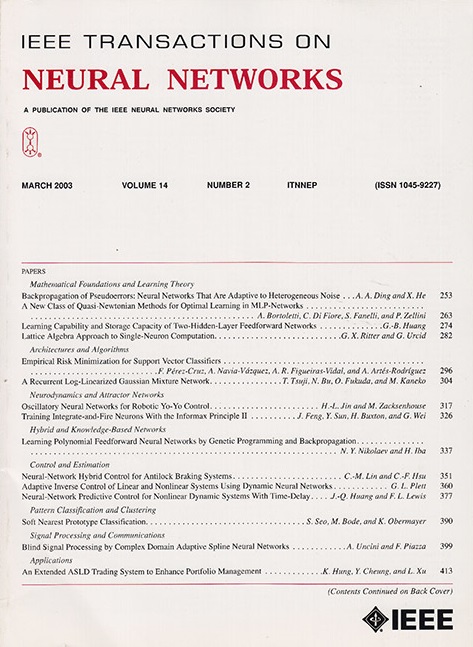SAGN:用于识别双视图脑网络的稀疏自适应门控图神经网络(Sparse Adaptive Gated Graph Neural Network with Graph Regularization)。
IF 8.9
1区 计算机科学
Q1 COMPUTER SCIENCE, ARTIFICIAL INTELLIGENCE
IEEE transactions on neural networks and learning systems
Pub Date : 2024-08-15
DOI:10.1109/TNNLS.2024.3438835
引用次数: 0
摘要
由于缺乏阈值选择的黄金标准,用不恰当的阈值构建的大脑网络有拓扑退化或包含噪声连接的风险。因此,图神经网络(GNN)在识别大脑网络时表现出弱鲁棒性和过拟合问题。此外,现有研究主要关注强耦合连接,而忽视了其他复杂系统的大量证据,而这些证据凸显了弱耦合连接的价值。因此,弱耦合大脑网络的潜力仍未得到开发。在本研究中,我们开创性地构建了弱耦合大脑网络,并验证了它们在情绪识别任务中的价值。随后,我们提出了一种稀疏自适应门控 GNN(SAGN),它能同时感知双视角(即强耦合和弱耦合)脑网络的宝贵拓扑结构。SAGN 包含一个稀疏自适应全局感受野。此外,SAGN 还采用了具有特征增强和自适应噪声抑制能力的门控机制。为了解决 SAGN 缺乏归纳偏差和容量大的问题,我们引入了基于双视角大脑网络先验拓扑的图正则化项,以增强泛化能力。除了公共数据集(SEED),我们还建立了一个包含 60 名受试者的自定义数据集(MuSer),以评估弱耦合脑网络的价值并验证 SAGN 的性能。实验证明,与不同情绪状态相关的大脑生理模式是可分离的,并植根于弱耦合大脑网络。此外,SAGN 在识别脑网络方面表现出卓越的泛化能力和鲁棒性。本文章由计算机程序翻译,如有差异,请以英文原文为准。
SAGN: Sparse Adaptive Gated Graph Neural Network With Graph Regularization for Identifying Dual-View Brain Networks
Due to the absence of a gold standard for threshold selection, brain networks constructed with inappropriate thresholds risk topological degradation or contain noise connections. Therefore, graph neural networks (GNNs) exhibit weak robustness and overfitting problems when identifying brain networks. Furthermore, existing studies have predominantly focused on strongly coupled connections, neglecting substantial evidence from other intricate systems that highlight the value of weakly coupled connections. Consequently, the potential of weakly coupled brain networks remains untapped. In this study, we pioneeringly construct weakly coupled brain networks and validate their values in emotion identification tasks. Subsequently, we propose a sparse adaptive gated GNN (SAGN) that can simultaneously perceive the valuable topology of dual-view (i.e., strongly coupled and weakly coupled) brain networks. The SAGN contains a sparse adaptive global receptive field. Moreover, SAGN employs a gated mechanism with feature enhancement and adaptive noise suppression capabilities. To address the lack of inductive bias and the large capacity of SAGN, a graph regularization term built with prior topology of dual-view brain networks is introduced to enhance generalization. Besides a public dataset (SEED), we also built a custom dataset (MuSer) with 60 subjects to evaluate weakly coupled brain networks’ value and validate the SAGN’s performance. Experiments demonstrate that brain physiological patterns associated with different emotional states are separable and rooted in weakly coupled brain networks. In addition, SAGN exhibits excellent generalization and robustness in identifying brain networks.
求助全文
通过发布文献求助,成功后即可免费获取论文全文。
去求助
来源期刊

IEEE transactions on neural networks and learning systems
COMPUTER SCIENCE, ARTIFICIAL INTELLIGENCE-COMPUTER SCIENCE, HARDWARE & ARCHITECTURE
CiteScore
23.80
自引率
9.60%
发文量
2102
审稿时长
3-8 weeks
期刊介绍:
The focus of IEEE Transactions on Neural Networks and Learning Systems is to present scholarly articles discussing the theory, design, and applications of neural networks as well as other learning systems. The journal primarily highlights technical and scientific research in this domain.
 求助内容:
求助内容: 应助结果提醒方式:
应助结果提醒方式:


